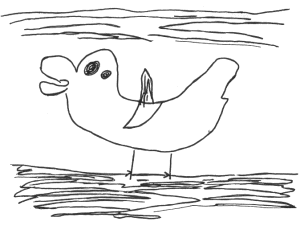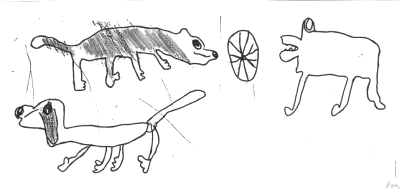Or search by topic
Number and algebra
Geometry and measure
Probability and statistics
Working mathematically
Advanced mathematics
For younger learners
Published 2011 Revised 2012
The Development of Spatial and Geometric Thinking: 5 to 18
This is the first in a series of articles looking at the development of spatial reasoning which aim to provide some insight into the way spatial thinking develops in children, and draws on a range of reported research. The first article in the series focuses on the work of Piaget and Inhelder. The next two look at coordinating space in drawings and the importance of instruction.
In the beginning . . .
The development of spatial awareness is already underway in new-born babies. To begin with, a baby's world is limited to the space close around him/her. Gradually, the baby explores objects within reach and begins to develop concepts such as 'near', 'far', 'up', 'down', 'big' and 'little'. At first these concepts are relative to oneself - "I reach out but can't touch it", or, "I can touch it but it won't fit in my hand". As the child gains the ability to move around, his/her world expands and new spatial ideas such as 'here', 'there', 'in', 'out', 'around', 'under' and 'over' form. Eventually these concepts are linked with language and refined and clarified to apply to a variety of situations.
Piaget and Inhelder
Research by Piaget and Inhelder (1956, 1960) suggest that early spatial conceptions are topological in nature. These basic topological ideas are very general and inclusive, and so give an infant a very broad understanding of his/her spatial world that can be refined with more detailed and complex perceptions. These perceptions can be described through the features of various types of geometry.
The observations gathered by Piaget and Inhelder led them to propose four stages of development in spatial thinking.
Sensori-motor Stage 0-2 years
Babies notice certain elementary features of objects, such as size and some contour, in a topological way. For example, a baby notices mother's eyes are inside the face shape. At first, the location of objects in space is seen in relation to the infant's own body. Later, as the infant begins to move around, the position of each object in space is referenced to its surroundings. For example, a
first perception of a ball might be that 'it is within reach of my hand', and a later view might be 'I see it under the table'. According to Piaget and Inhelder perceptions of surroundings include events, such as mother or father entering the room, and not just objects.
The four basic topological concepts are as follows:
- Proximity - the relative nearness of an object or event to any other object or event.
- Order - the sequence of objects or events (in time) according to size, colour or some other attribute. For example, if three toys are suspended in a line over a crib long enough for an infant to become familiar with them, he/she will notice if the sequence of the toys is changed.
- Separation - an object, event or 'space' coming between other objects or events. It also involves distinguishing between objects and parts of objects.
- Enclosure - an object or event surrounded by other objects or events, which involves the ideas of inside, outside and between.
Pre-operational Stage 2-7 years

Concrete Operational Stage 7-12 years

The child also begins to use the ideas associated with Euclidean Geometry such as distinguishing between straight and curved lines, specific shapes (like squares and circles), the length and number of sides and angles. These 'measurement' concepts allow children to bring objects and parts of object into relative proportion in their drawings.
The development of the co-ordination of horizontal and vertical planes is illustrated in the sequence of drawings below (McNally pp.45-46). Children ranging from 4 years to 10 years were asked to draw liquid in a tilted jar on a table, and to draw people or trees on a hillside. The youngest drawer clearly demonstrated Topological thinking, with the liquid simply shown inside the jar, and the
people enclosed by the hill. Gradually, as spatial thinking matures, the co-ordination of vertical and horizontal can be seen.

Formal Operational Stage 12-18 years
The understanding of geometric concepts continues to develop until complex formal systems of plane geometry can be used.
While Piaget and Inhelder suggest that the development of perception as described by the types of geometry are sequential (i.e. Topological, Projective, Euclidean), other researchers believe that all types of geometric thinking continue to develop over time and become increasingly integrated.
References
McNally, D. (1975). Piaget, Education and Teaching. Sydney:Hodder & Stoughton.
Piaget, J. and Inhelder, B. (1967). The Child's Conception of Space. New York: Norton.
Piaget, J., Inhelder, B. and Szeminski, A. (1960). The Child's Concepti

